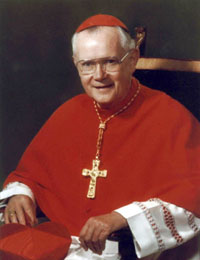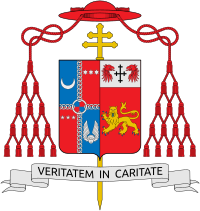James Aloysius Hickey facts for kids
Quick facts for kids His Eminence James Aloysius Hickey |
|
|---|---|
| Cardinal Archbishop of Washington |
|
 |
|
| Church | Roman Catholic Church |
| See | Archdiocese of Washington |
| Appointed | June 17, 1980 |
| Enthroned | August 5, 1980 |
| Reign ended | November 21, 2000 |
| Predecessor | William Baum |
| Successor | Theodore Edgar McCarrick |
| Other posts | Cardinal Priest of Santa Maria Madre del Redentore a Tor Bella Monaca |
| Orders | |
| Ordination | June 15, 1946 |
| Consecration | April 14, 1967 by John Francis Dearden |
| Created Cardinal | June 28, 1988 |
| Rank | Cardinal-Priest |
| Personal details | |
| Born | October 11, 1920 Midland, Michigan, USA |
| Died | October 24, 2004 (aged 84) Washington, D.C., USA |
| Buried | Cathedral of St. Matthew the Apostle |
| Previous post |
|
| Motto | Veritatem in caritate (Truth in charity) |
| Coat of arms |  |
| Styles of James Hickey |
|
|---|---|
 |
|
| Reference style | His Eminence |
| Spoken style | Your Eminence |
| Informal style | Cardinal |
| See | Washington |
James Aloysius Hickey (October 11, 1920 – October 24, 2004) was an important American cardinal in the Roman Catholic Church. He served as the Archbishop of Washington from 1980 to 2000. He became a cardinal in 1988. Before this, Hickey was the bishop of the Diocese of Cleveland in Ohio from 1974 to 1980.
Cardinal Hickey greatly expanded help for poor and sick people in the Washington area through the Archdiocese of Washington. He also spoke out against some U.S. foreign policies in countries like Nicaragua and El Salvador. He was a strong supporter of nuclear disarmament, which means getting rid of nuclear weapons.
Contents
Biography
Early Life and Education
James Hickey was born on October 11, 1920, in Midland, Michigan. His parents were James and Agnes Hickey. His father was a dentist who helped patients even if they couldn't pay during the Great Depression.
When James was 13, he started studying at St. Joseph Minor Seminary in Grand Rapids, Michigan. He later graduated at the top of his class from Sacred Heart Major Seminary in Detroit in 1942. While studying, he helped migrant workers. He then continued his studies at The Catholic University of America in Washington, D.C.
Becoming a Priest
James Hickey became a priest for the Diocese of Saginaw on June 15, 1946. He then worked as an assistant pastor at St. Joseph's Parish in Saginaw, Michigan. In 1947, he went to Rome to study more. He earned advanced degrees in Church law and theology by 1951.
After returning to Michigan, he worked as a secretary for Bishop Stephen Stanislaus Woznicki for many years. He also helped start St. Paul Seminary. From 1962 to 1965, Hickey attended the Second Vatican Council in Rome. This was a very important meeting for the Catholic Church. He helped Bishop Woznicki during this time. In 1963, he was given the special title of Monsignor.
Serving as a Bishop
On February 18, 1967, Pope Paul VI chose Hickey to be an auxiliary bishop for the Diocese of Saginaw. He officially became a bishop on April 14, 1967. His special saying as a bishop was Veritatem In Caritate, which means "Truth in Charity."
From 1968 to 1969, Hickey led a committee on training priests for the United States Conference of Catholic Bishops (USCCB). In 1969, he became the head of the Pontifical North American College in Rome. There, he helped train American seminarians (students preparing to be priests) for five years.
Leading the Cleveland Diocese
On May 31, 1974, Hickey was named the bishop of the Diocese of Cleveland. He officially started his new role on July 16, 1974. In Cleveland, Bishop Hickey worked hard to promote racial unity. He also became very involved in issues of justice in El Salvador.
In 1980, he traveled to El Salvador for the funeral of Archbishop Óscar Romero, a famous leader who was killed. Two American women, Sister Dorothy Kazel and Jean Donovan, who Hickey had sent to serve as missionaries in El Salvador, were later sadly killed there. He kept their pictures in his private chapel to remember them.
Archbishop of Washington
Pope John Paul II appointed Hickey as the archbishop of the Archdiocese of Washington on June 17, 1980. During the 1980s, Archbishop Hickey spoke to members of the United States Congress. He asked them to stop sending aid to the Contra insurgents in Nicaragua. He also encouraged other American bishops to speak out against more military spending and to support nuclear disarmament.
During the Salvadoran Civil War, Hickey disagreed with the Reagan administration's support for the military government in El Salvador. In 1981, he told a U.S. House committee that he opposed military help and interference from all outside countries. He worried about a Communist takeover but believed military aid would only make things worse.
Becoming a Cardinal
Pope John Paul II made Hickey a cardinal on June 28, 1988. At that time, he was one of thirteen American cardinals. That same year, Cardinal Hickey was asked to lead a special spiritual retreat for the Pope and his staff.
Within the USCCB, Cardinal Hickey led several committees. These included committees on Catholic teachings and human values.
Cardinal Hickey's time in Washington D.C. saw a huge growth in Catholic Charities. This organization became the largest private social service group in the area. He also started many new programs, such as:
- The Archdiocesan Health Care Network to help people get medical care.
- The Archdiocesan Legal Network, which offers free legal help to people with low incomes.
- Birthing and Care, providing medical care for pregnant women and new mothers in need.
- Faith in the City, a plan to improve Catholic schools in inner cities.
- Victory Housing, which builds homes for senior citizens who need some help or want to live independently.
Working with Mother Teresa, Cardinal Hickey also helped start a convent in Washington for the Missionaries of Charity. This group helps people who are homeless or very sick. Cardinal Hickey retired as archbishop on November 21, 2000, after 20 years of service.
Cardinal Hickey's Views
Besides his work for social justice, Cardinal Hickey was known for his strong beliefs about Catholic teachings.
Supporting Catholic Teachings
Cardinal Hickey made sure that groups working with the Church followed Catholic teachings. For example, he asked a group for LGBT Catholics, called New Ways Ministry, to stop using archdiocese property. He also asked Georgetown University to stop a national LGBT ministry group, DignityUSA, from holding Mass on campus in 1987.
He also addressed concerns about how Mass was celebrated at Holy Trinity Church in Georgetown. He even sent then-auxiliary bishop William E. Lori to look into the matter.
As the head of The Catholic University of America, Cardinal Hickey handled the situation when a theologian named Charles Curran left the university's teaching staff in 1987 due to disagreements over Catholic doctrine.
Views on Important Issues
In early 2000, following calls from the Pope, Cardinal Hickey asked Maryland Governor Parris Glendening to change the death sentence of Eugene Colvin-El. This showed his opposition to capital punishment.
While he was Archbishop of Washington, Cardinal Hickey also made sure that all large building projects for the archdiocese used union workers.
Death and Burial
Cardinal Hickey passed away on October 24, 2004, at the age of 84. He died at the Jeanne Jugan Home of the Little Sisters of the Poor in Washington, D.C. After a funeral Mass at the National Shrine of the Immaculate Conception, he was buried in St. Francis Chapel at St. Matthew's Cathedral.
See also
 In Spanish: James Aloysius Hickey para niños
In Spanish: James Aloysius Hickey para niños

